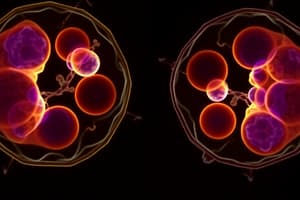Podcast
Questions and Answers
What is the main difference in cytokinesis between plant cells and animal cells?
What is the main difference in cytokinesis between plant cells and animal cells?
- Plant cells pinch the membrane to separate, while animal cells form a cell wall.
- Both cell types form a new nucleus during cytokinesis.
- Animal cells create a cell plate, while plant cells divide without any structure.
- Plant cells form vesicles to create a new cell wall, while animal cells pinch the cytoplasm. (correct)
During which phase of the cell cycle does the DNA duplication occur?
During which phase of the cell cycle does the DNA duplication occur?
- Prophase
- Telophase
- Anaphase
- Interphase (correct)
What is the total number of strands of DNA at the beginning of mitosis in a human cell?
What is the total number of strands of DNA at the beginning of mitosis in a human cell?
- 46
- 23
- 184
- 92 (correct)
Which sequence correctly describes the process of binary fission in prokaryotic cells?
Which sequence correctly describes the process of binary fission in prokaryotic cells?
After mitosis, how many daughter cells are produced from a typical eukaryotic cell division?
After mitosis, how many daughter cells are produced from a typical eukaryotic cell division?
What is the role of proto-oncogenes during Interphase?
What is the role of proto-oncogenes during Interphase?
What happens if a cell fails the checkpoint during Interphase?
What happens if a cell fails the checkpoint during Interphase?
What is formed during the process of cytokinesis?
What is formed during the process of cytokinesis?
During which phase of mitosis do chromosomes line up at the metaphase plate?
During which phase of mitosis do chromosomes line up at the metaphase plate?
What occurs during the S phase of Interphase?
What occurs during the S phase of Interphase?
Which process refers to the programmed cell death of unhealthy cells?
Which process refers to the programmed cell death of unhealthy cells?
What shape do chromosomes take prior to cell division?
What shape do chromosomes take prior to cell division?
What is the primary purpose of cell division?
What is the primary purpose of cell division?
Flashcards
Mitosis
Mitosis
The process of cell division that occurs in eukaryotic cells (cells with a nucleus). During mitosis, a parent cell divides into two identical daughter cells, each with the same number of chromosomes as the parent cell.
Metaphase
Metaphase
The stage of mitosis where the duplicated chromosomes line up in the middle of the cell, preparing to be pulled apart.
Cytokinesis
Cytokinesis
The process of dividing the cytoplasm of a cell after mitosis or meiosis, resulting in two separate daughter cells.
Binary Fission
Binary Fission
Signup and view all the flashcards
Interphase
Interphase
Signup and view all the flashcards
Proto-oncogenes
Proto-oncogenes
Signup and view all the flashcards
Tumor suppressor genes
Tumor suppressor genes
Signup and view all the flashcards
Apoptosis
Apoptosis
Signup and view all the flashcards
Spindle fibers
Spindle fibers
Signup and view all the flashcards
Study Notes
Cell Cycle Overview
- Cells grow and reproduce through a cyclical process.
- Interphase is the time between cell divisions, where cells perform normal functions.
- Proto-oncogenes promote cell growth and division.
- Tumor suppressor genes monitor and control cell process.
- Checkpoints ensure the health of the cell before division. If a cell fails a checkpoint, it may undergo repair or programmed cell death.
- Cell division includes mitosis (nuclear division) and cytokinesis (cytoplasm division).
Interphase
- Interphase comprises three phases: G1, S, and G2.
- G1: Cell growth, normal cell activities.
- S: DNA replication.
- G2: Preparation for mitosis.
- Interphase is where the cell prepares for mitosis.
- DNA from each parent, mom and dad, is replicated during S phase to ensure a full set in each new cell. Two identical sets of DNA exist.
Mitosis
- Mitosis is a type of cell division that produces two genetically identical daughter cells from a single parent cell.
- Mitosis consists of 4 distinct phases: Prophase, Metaphase, Anaphase, and Telophase.
- Mitosis is critical for growth, repair, and asexual reproduction in multicellular organisms.
- During mitosis, the replicated chromosomes are separated and distributed to two new nuclei.
Mitosis-Prophase
-
Chromosomes condense and become visible.
-
Sister chromatids become attached together.
-
Spindle fibers form, attaching to the centromere of each chromosome.
-
Nuclear envelope breaks down.
-
The cell has 4 chromosomes and 8 DNA strands at the start of Mitosis-Prophase.
Mitosis-Metaphase
- Chromosomes line up along the metaphase plate (the center of the cell).
- Sister chromatids remain attached together but are lined up.
Mitosis-Anaphase
- Spindle fibers pull sister chromatids apart, to the opposite sides of the cell.
- Two identical sets of chromosomes now exist on opposite sides of the cell.
Mitosis-Telophase
- Chromosomes arrive at the poles of the cell.
- Nuclear envelopes re-form around each set of chromosomes.
- Spindle fibers disappear.
Cytokinesis
- Cytoplasm divides, creating two separate daughter cells.
- Cytokinesis is the final step of cell division.
Plant Cell Division
- Plant cells, during cytokinesis, form a cell wall by creating vesicles that fuse to form a new cell wall at the center of the dividing plant cell. This contrasts with animal cell cytokinesis, where the cell membrane pinches inward.
Prokaryotic Cell Division
- Prokaryotic cells, like bacteria, divide through a process called binary fission.
- The process begins by replicating chromosomal DNA and separating the copied DNA molecules from each other.
- The cell elongates, eventually dividing into two new, genetically identical daughter cells.
Summary of Cell Division
- Daughter cells are genetically identical to the parent cell (and each other).
- The number of chromosomes in the parent cell remains constant after one round of cell division.
Studying That Suits You
Use AI to generate personalized quizzes and flashcards to suit your learning preferences.




